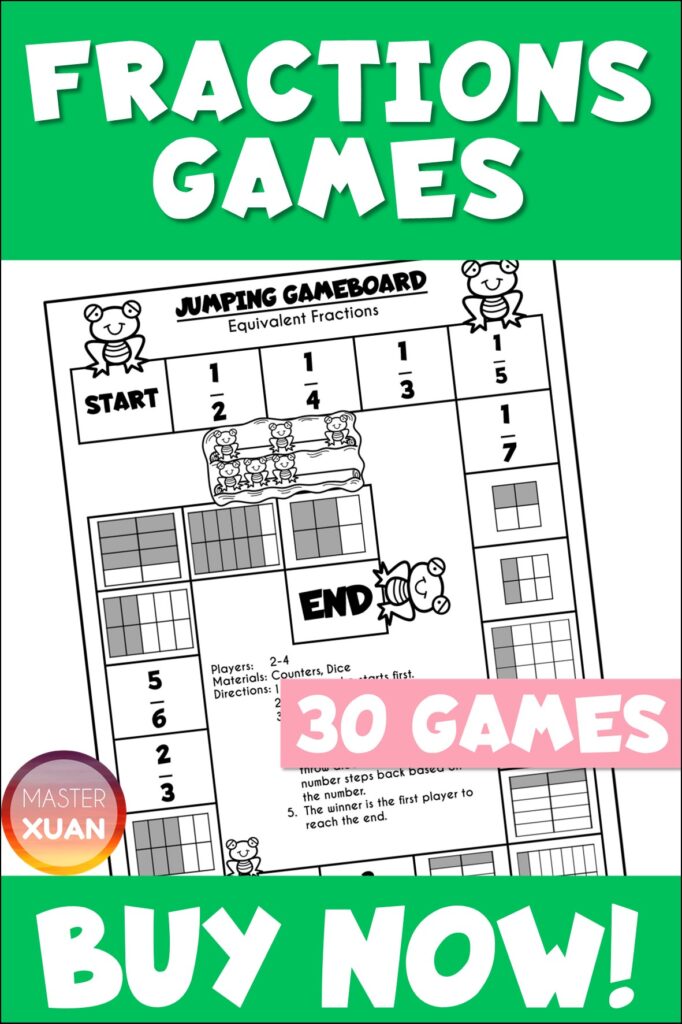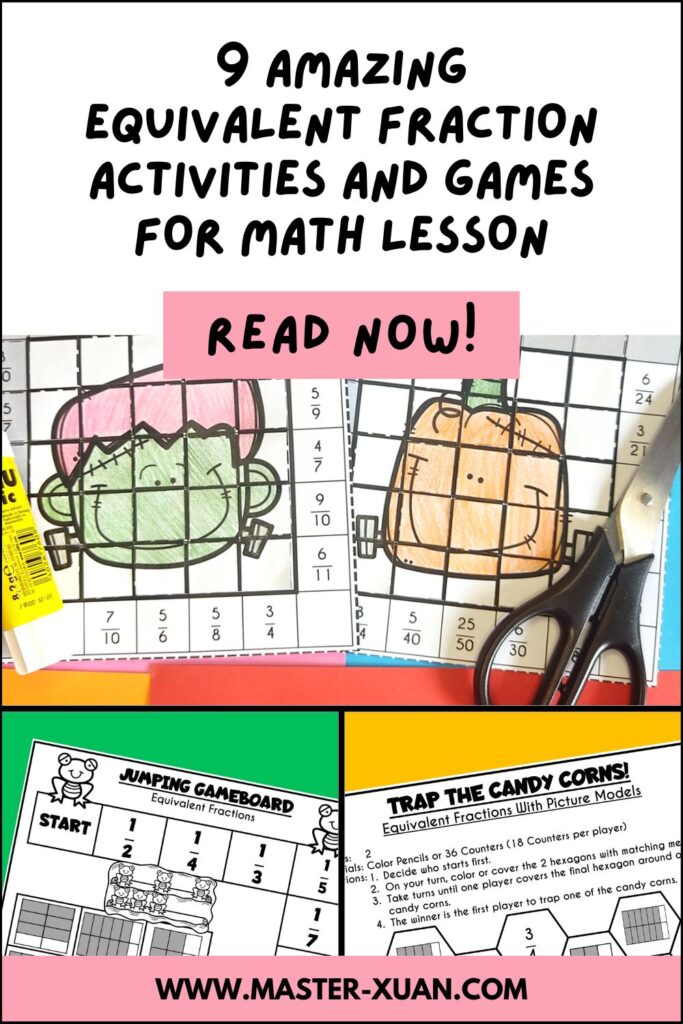Make your equivalent fractions lesson fun and enjoyable with these Equivalent Fraction Activities And Games mentioned in this blog!
There are plenty of activities no matter if you are just introducing the concept or revising them.
Personally, I think there are 3 main stages of teaching equivalent fractions. Know which stage you are at so you can find the appropriate one for your students.
- If you are just introducing students to this concept, and students only have basic understanding of equivalent fractions, look for those with visual models.
- Or if you need practice with multiplying the numerator and denominator with the same number to make an equivalent fraction, choose those with just fractions.
- The last that is related to equivalent fractions is to practice simplifying fractions.
You will need equivalent fraction activities for all these 3 stages so that you can use them for differentiation or revision.
In this blog post, I’m going to introduce you to 9 fun and engaging equivalent fraction activities and games that your students can do to get extra practice to enhance their understanding of fractions.
Quiz Game Show
I mentioned the quiz game show in various blog posts previously, so do check them out to learn in great detail how it works.
In my Primary 3 (third grade) Fraction Quiz Game Show, one of the categories is equivalent fractions.
So you can choose to just do just equivalent questions as a review or play the whole game and review them with other fractions skills.

Students just love the interactive features and you can always incorporate this fun activity into small group or whole group settings.
Simply put, students will get points if they get the correct answer. This is also a great way to quiz their understanding of the math concepts in a fun way.
The best part about using these fraction task cards is they are NO PREP and SELF-CHECKING. This means so much time is saved for you and students get instant feedback.
Do check out this equivalent fractions activity if you are interested.

Paper Weaving
This is a unique hands-on activity that I came up with. Similarly, you can grab Equivalent Fractions Hands On Activities in my tpt store.

Students need to cut out the strips and grid from the template. Then start matching the fractions on the strips to the grid.

Students can use the equivalent fractions worksheet to write out their workings.
This is relatively self-checking. If students are unable to pair all of it, this means there are some errors.
If you require extra checking, you can also ask students to weave first. When they get a perfect picture, it means there are no errors.
Alternatively, you can go through the answers as a whole class too. An answer key is provided which makes this also a great activity for substitutes too.
Anyway, once students aligned the strips, you can glue the first box of each strip to the grid. This makes it easier to weave later.

I’ll like to fold back a little on the bold lines to make them stay in place.
Then it’s time to start weaving!

The trick here is to place the strip in the middle of each column and row.
I’ll glue the strips in place by gluing the last box of the strips down as well as the back of it.
This makes sure it stays in place and wouldn’t move around when you color later.
The last step is to fill it in by using crayons, colored pencils, or markers.

Students have so much fun while practicing these fraction concepts.
Maze
This game and the following 7 other equivalent fractions games that I’m going to introduce later can be found in this resource in my Teachers Pay Teachers store.
In this resource, there are 2 types of equivalent mazes: independent and partner games.

1 to 2 players.
How to play:
Throw 2 dice to form a fraction (i.e. 3 & 2). Find the fractions with the 2 numbers and write an equivalent fraction. Then shade/color the box.
All equivalent fractions you write must be different! This is the part of instructions that students tend to ignore. So do emphasize this if you want to make it a bit more challenging and for students to come up with different equivalent fractions.
But if you wish to lower the difficulty level, you can also ask students to ignore that part of the instruction.
If there are no more boxes to shade, throw the dice again.
Keep doing it, until you form a trail from the start to the end. The trail needs to be connected horizontally or vertically.
This takes a bit of luck and time to complete.
If you prefer a shorter game, I also provide a shorter game that can be played by 2.
Basically, partners will compete to see who uses the least number of boxes to form a trail from the start to the end.
Five-in-a-row
There are 2 types of Five-in-a-row that review Equivalent Fractions With Picture Models:
Hoot Five-In-A-Row
Bumpy Five-In-A-Row
2 players
How to play:
Players take turns rolling the dice.
Then find the matching equivalent fraction on the grid and cover the box with a counter.
The first player to create a line of 5 boxes (vertically, horizontally, and diagonally) is the winner!
The Bumpy Five-In-A-Row, has similar gameplay. Here’s the additional twist of the game:
if you begin with a bump, you can place any box. If not, you can choose to replace another player’s counter with yours.
Race it!
2 to 4 players.
How to play:
Players take turns rolling the dice and find the column on the gameboard with the number on the dice.
The player then writes an equivalent fraction for the first space on the path to the pumpkin.
If they answer correctly, they cover the space with a counter or write down the answer.
Continue taking turns, answering, and covering the spaces.
The first player to reach the pumpkin by covering the last space on the path is the winner!
Tic Tac Toe

There are 3 different gameboards that practice equivalent fractions.
- With picture models
- Finding bigger equivalent fractions
- Simplifying fractions
2 players
How to play:
On your turn, roll 2 dice and add them together.
Find the sum of the dice in the chart and look at the question given.
Find ONE box in the 3 gameboards that contains the answer.
Cover the answer with one of your counters OR color the box. If there is no available box, you will skip a turn.
Take turns until one player covers a line (vertical, horizontal, or diagonal) of 3 boxes on any of the 3 gameboards.
Trap it!
This game has 2 gameboards: with and without picture models.
2 players
How to play:
Decide who starts first.
On your turn, color or cover the 2 hexagons with matching measurements.
Take turns until one player covers the final hexagon around one of the candy corns.
The winner is the first player to trap one of the candy corns.

Squares
2 to 4 players.
How to play:
Throw the dice and find the number in the chart.
Then, find the box with the answer.
Draw a line between two of the dots surrounding that answer. (Each player should use different colored pencils/crayons/markers.)
The student who draws the last line to form a complete square will get to capture that square.
Color or write initials in the square to capture it.
If there is no more line to draw, the student will miss a turn.
The student with the most squares at the end of the game is the winner!
Jumping Gameboard

2 to 4 players.
How to play:
Decide who starts first.
On your turn, throw the dice.
After landing on the space, jump to the next space with the matching equivalent fraction.
If you land on MOVE BACK, throw dice and move the number steps back based on the number.
The winner is the first player to reach the end.
It can get a bit tedious and repetitive when students keep moving back. But that’s the purpose, isn’t it? To let them willingly do the repeated practice.
However, if the game is taking too long, you can limit the number of times they need to move backward if they land on the same spot.
Final Thoughts
Don’t you think it is amazing how many different equivalent fraction activities students get to do just for this one math skill?
If you wish to play all of the math games mentioned, remember to check out Fractions Games Maths! There are other math fraction games with other fraction skills included too.
After all, we all know the best way and the easy way to get students to enjoy fraction lessons is by playing games! They are great for math centers too.
Here are some additional ideas on how to teach these math skills.
- The simple way to show equivalent fractions examples is by using fractional models or comparing different fractions on a number line.
- If you don’t have access to manipulatives such as fraction tiles or pattern blocks, consider virtual manipulatives.
Have fun with these equivalent fraction activities and games!
Related Read: 7 Simple Ways To Practice With Fractions And Engage Students
Here are some pins that you can save to bookmark this post. Save them to your Pinterest Board now! ↓








